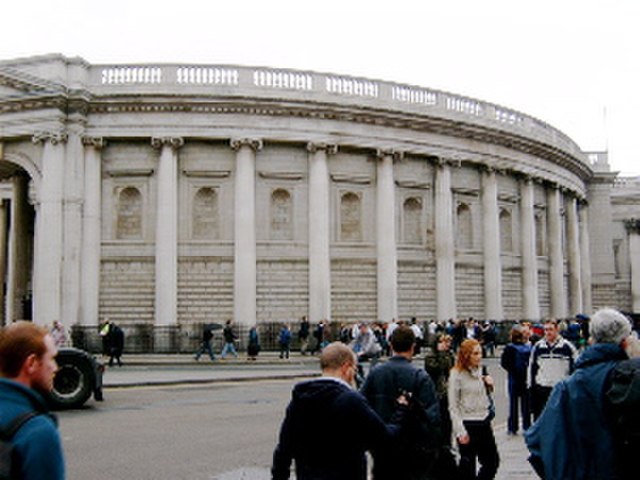Irish politics is in many ways unique, with names, practices and structures that will be new to many of you starting your journey in Trinity. With that in mind, this guide will hopefully be a helpful introductory tool so you can follow politics in Ireland as we approach a general election during this academic year.
Institutions
Ireland’s parliament, the Oireachtas, has two houses, the Seanad (Senate) and the more powerful, directly elected lower house, Dáil Eireann, which we’ll focus our attention on. Members of the Dáil are known as TDs. The President of Ireland is Michael D. Higgins, in his second and final term having been in office since 2011. The President is a mainly ceremonial position, power mainly lies with the Taoiseach (equivalent to Prime Minister). The next presidential election is due for 2025.
Elections
Ireland uses Proportional Representation by Single Transferable Vote (PR-STV) for all elections. It’s complicated but essentially, voters rank the candidates on their ballot for local constituencies where multiple TDs will be elected. This gives Irish elections a significant local element while keeping the nationwide results mostly proportional. The only other parliaments elected with this system are Northern Ireland and Malta.
Parties
The largest party is currently Fianna Fáil. They’ve historically dominated Irish politics, being the largest party after every single election from 1932 until their historic third place in 2011,due to backlash after the 2008 economic crisis. Their leader has been the current Tánaiste (Deputy Prime Minister) Micheál Martin ever since then. A Christian democrat-esque centre-right party, they are part of the current coalition government.
Fine Gael are traditionally the second-largest party, and have been in every government since 2011, being the other major partner of the current coalition. While every government in history has been led by one of the two, this is the first time that they have been in government together. Unlike most other countries, there is no clear left-right divide between the two, with Fine Gael also being centre-right ideologically. Although Fine Gael have generally been more socially liberal, from supporting legal contraception in 1985 to abortion in 2018, many would view the parties as lacking meaningful differences today. Fine Gael is led by current Taoiseach Simon Harris, who became the youngest ever to hold the office in April of this year.
The largest opposition party is Sinn Féin. They are an all-island party, and the largest in Northern Ireland, primarily focused on Irish unity. Usually positioned on the political left, Sinn Féin’s historic associations with the IRA are a source of controversy, but under their current leader Mary Lou McDonald, who took over in 2018 from Gerry Adams (leader since 1983), the party has worked to broaden their appeal and has risen to a level of support to rival to the historically dominant Fine Gael and Fianna Fáil.
The third party in government is the Greens, who achieved their best result of 12 seats in 2020. Since going into government after that, they have lost a lot of their support and face the risk of being wiped out at the next election. Their long-time leader Eamon Ryan stood down in June, being replaced by Roderic O’Gorman.
The oldest party in the Dáil is Labour, founded in 1912 and historically Ireland’s third-largest party. In 2011 they achieved their best ever result of 37 seats and formed a government with Fine Gael. The austerity measures implemented to combat the recession resulted in them losing many of their voters and they collapsed to 7 seats in 2016. They have 7 TDs, though one was recently elected to the European Parliament and will vacate their seat. They are a centre-left party currently led by Ivana Bacik.
There are a number of relatively newer parties in the Dáil. People Before Profit and Solidarity, founded in 2006 and 2014 respectively, are socialist parties in an alliance, with a combined 5 seats. The Social Democrats, led by Holly Cairns, were founded in 2015 in a split from Labour, and have enjoyed a respectable increase in support, becoming the largest party in Dublin City Council at the recent local elections. Aontú were founded by Peadar Tóibín in 2019, after he left Sinn Féin because of their pro-choice stance; they are considered to be socially conservative and fiscally liberal. Right to Change is another minor left wing party, currently with 1 seat. Finally, Independent Ireland was founded in 2023. Led by Michael Collins, they are a conservative party with a focus on rural issues. There are many parties without Dáil representation, including multiple far right ones.
No discussion of Irish politics would be complete without mentioning independent politicians. There are 19 TDs elected as independents in the Dáil – more than in every other EU national parliament combined. Independents have been a mainstay in Irish politics since independence and have propped up many minority governments in the past, even being part of government on occasions (including 2016-2020). They come from all ideological and geographic backgrounds, from left-wingers like Catherine Connolly to rural conservatives like Michael Healy-Rae.
Key Issues
The biggest issue in Irish politics is housing, due to the ongoing crisis of high prices and low supply leading to many people being unable to afford a home and record homelessness. Recently migration has become a hot topic, with the government’s policy towards migrants drawing criticism from the left and an emergent far right in light of the issue. Other important issues are the failing health service, the cost of living crisis, and the climate crisis.







